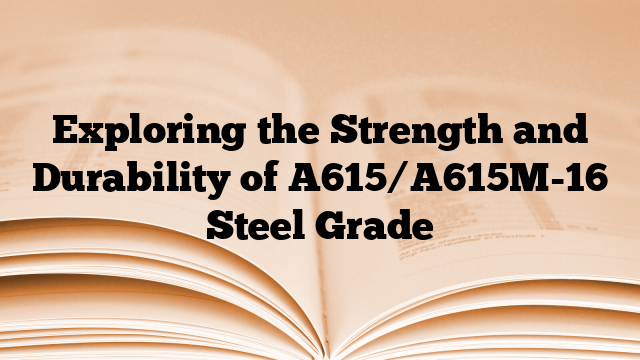Exploring the Strength and Durability of A615/A615M-16 Steel Grade
The A615/A615M-16 steel grade is commonly used in the construction industry for reinforced concrete structures. It is known for its strength and durability, making it suitable for applications where high load-bearing capacity is required.
The chemical composition of A615/A615M-16 steel grade is as follows:
– Carbon (C): 0.30% maximum
– Manganese (Mn): 0.80-1.50%
– Silicon (Si): 0.15-0.50%
– Sulfur (S): 0.05% maximum
– Phosphorus (P): 0.06% maximum
These chemical elements contribute to the overall strength and durability of the steel grade. Carbon provides strength and hardness, while manganese enhances the steel’s ductility and toughness. Silicon improves the steel’s resistance to oxidation and scaling. Sulfur and phosphorus, although limited to low amounts, can have a negative impact on the steel’s properties if present in excessive quantities.
In terms of mechanical properties, A615/A615M-16 steel grade has the following specifications:
– Tensile strength: 75,000-100,000 psi (520-690 MPa)
– Yield strength: 60,000-90,000 psi (420-620 MPa)
– Elongation: 8-14% (depending on the diameter of the steel)
These mechanical properties demonstrate the steel grade’s ability to withstand high tensile loads and provide an acceptable level of ductility and elongation. The yield strength indicates the point at which the steel begins to deform permanently, while the tensile strength represents the maximum load it can withstand before failure.
The A615/A615M-16 steel grade is standardized by the American Society for Testing and Materials (ASTM) under the standard number A615/A615M-16. This standard specifies the requirements for deformed and plain carbon-steel bars for concrete reinforcement. It ensures that the steel meets the necessary strength and quality criteria necessary for use in construction.
Overall, the A615/A615M-16 steel grade offers excellent strength and durability properties, making it a popular choice for various construction applications where reinforced concrete structures are required to withstand high loads and environmental conditions.

